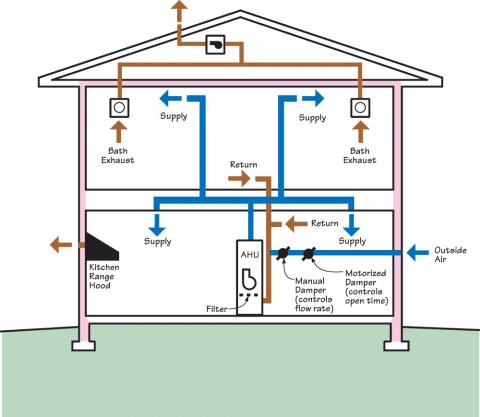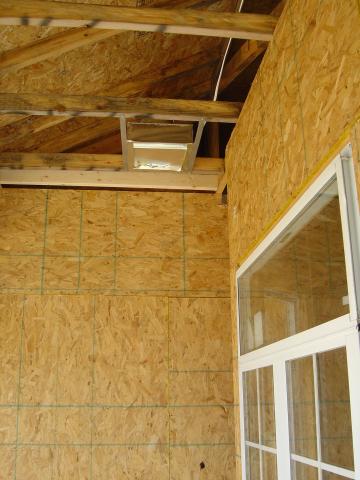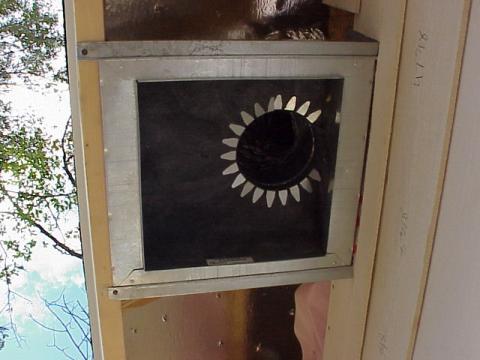Where Are Makeup Air Inlets Placed
Ventilation Air Inlet Locations
Telescopic
Install fresh air ventilation inlets away from contamination sources.
- Install air inlets at least 10 feet abroad from all contagion source terminations. Install air inlets in the wall at least 3 feet abroad from dryer exhausts and contamination sources that exit through the roof (as required by Energy STAR Certified Homes).
- Install air inlets at to the lowest degree 2 feet above form or above the roof deck in Climate Zones ane—3 and at least 4 feet above course or in a higher place the roof deck in Climate Zones 4—8 (equally required by ENERGY STAR Certified Homes). Annotation: it is easier to install an air inlet at the gable end of the house than to try to lift it off the roof two to iv feet.
- Ensure that ventilation air comes directly from outdoors and not from next dwelling units, garages, crawlspaces, or attics.
- Install the air inlet duct in a location with the shortest, most direct path possible to the air handler unit, HRV, or ERV.
- Stretch the duct tight and support it adequately to minimize sagging and kinks.
- Air seal around the intake duct termination and seal the duct to the HRV/ERV or return side of the air handler with mechanical fasteners and metal record or mastic.
- Install a ≤ 0.5-in.-mesh screen on all air inlets to proceed out rodents, insects, and droppings, except use a louvered damper rather than a mesh screen on dress dryer vents.
See the Compliance Tab for related codes and standards requirements, and criteria to see national programs such as DOE'southward Zip Energy Ready Home program, ENERGY STAR Certified Homes, and EPA Indoor airPLUS.
Description
When a home has a balanced ventilation system that uses a rut recovery ventilator (HRV), energy recovery ventilator (ERV), or fundamental-fan-integrated supply ventilation, fresh air is brought into the home through a ventilation air inlet. To ensure good air quality, the inlet should be placed in a location away from possible sources of contamination, and where information technology has unobstructed access to clean air.
Possible contamination sources include bathroom frazzle fans, plumbing vent pipes, kitchen frazzle fans, dryer frazzle vents, furnace exhaust vents, water heater frazzle vents, fireplace flues, and whole-business firm fans. The locations for these outlets and inlets should be specified on plans. In add-on, the HVAC contractor should coordinate with other subcontractors, including the framers, plumbers, and electricians, at the beginning of structure to determine the proper placement of both air inlets and contamination source terminations.
The air inlet should be located loftier enough above the ground, or roof surface, to prevent accumulated snowfall from piling up over it, rainwater from splashing into information technology, and plants from growing into it. It should exist located outside, not in an attic, crawlspace, garage, or attached dwelling. The inlet should be covered with a mesh screen to prevent animal and insect entry. Ideally, it should be placed in a location where the home owner can bank check and clean information technology regularly.
Where to Install Ventilation Air Inlets
1. Verify locations of all contamination source terminations.
two. Install fresh air inlets so that they are
- at to the lowest degree x feet abroad from all contagion source terminations
- at least 3 feet abroad from dryer exhausts and contamination sources exiting through the roof
- at to the lowest degree 2 feet above grade or above the roof deck in Climate Zones one-3
- at to the lowest degree four anxiety to a higher place grade or in a higher place the roof deck in Climate Zones 4-eight.
* Note: it is easier to install an air inlet at the gable terminate of the house than to try to elevator it off the roof 2-4 feet.
3. Install the air inlet duct in a location with the shortest, almost direct path possible to the air handler unit of measurement, HRV, or ERV. Stretch the duct tight and back up it adequately to minimize sagging and kinks. Air seal effectually the intake duct termination and seal the duct to the HRV/ERV or render side of the air handler with mechanical fasteners and metal tape or mastic.
iv. Install a ≤ 0.v-in.-mesh screen on all air inlets to proceed out rodents, insects, and debris, except clothes dryer vents which should have a louvered damper instead. See the guide Proper Wearing apparel Dryer Venting for more information.
On the diagram of a business firm below, which has central-fan-integrated supply ventilation, the fresh air intake is located more than 4 feet above grade level and abroad from other contaminant sources such as other flue or exhaust piping outlets on the house.

The metal frame for the fresh air intake duct grille has been installed in the ceiling of a covered porch of this habitation under structure.

The intake and duct have been installed for the fresh air inlet in the eave of the roof of this home nether construction. The grille has not still been installed.

Ensuring Success
Visually audit the ventilation inlet to ensure that it is at least ten anxiety from whatever known contamination sources, at least two anxiety above grade and in a higher place the roof deck in IECC Climate Zones ane-3 and at least four feet above grade and above the roof deck in IECC Climate Zones 4 through 8. Brand sure the inlet is non obstructed by whatever objects, that the ventilation air comes from outdoors—not from a garage, attic, crawlspace, or adjacent dwelling, and that the ventilation inlet is covered with a protective screen with ≤ 0.five–inch mesh. Dryer vents should have a louvered damper, not a mesh screen, roofing the outside end.
Climate
No climate specific information applies.
The Compliance tab contains both program and code data. Code language is excerpted and summarized below. For exact code linguistic communication, refer to the applicable lawmaking, which may require buy from the publisher. While we continually update our database, links may have inverse since posting. Please contact our webmaster if yous find cleaved links.
Energy STAR Certified Homes, Version three/3.1 (Rev. 09)
Rater Field Checklist
seven. Whole-House Mechanical Ventilation Arrangement
7.vii Air inlet location (Consummate if ventilation air inlet location was specified (ii.12, 2.13); otherwise cheque "N/A"):46, 47
seven.7.1 Inlet pulls ventilation air directly from outdoors and not from attic, crawlspace, garage, or adjacent dwelling unit.
vii.vii.two Inlet is ≥ 2 ft. to a higher place grade or roof deck; ≥ 10 ft. of stretched-string altitude from known contamination sources (e.1000., stack, vent, exhaust, vehicles) not exiting the roof, and ≥ 3 ft. distance from sources exiting the roof.
7.7.3 Inlet is provided with rodent / insect screen with ≤ 0.5 inch mesh.
Footnote 46) Ventilation air inlets that are just visible via rooftop admission are exempted from Item seven.7 and the Rater shall mark "n/a". The outlet and inlet of balanced ventilation systems shall meet these spacing requirements unless manufacturer instructions indicate that a smaller distance may be used. Nonetheless, if this occurs the manufacturer's instructions shall be nerveless for documentation purposes.
Footnote 47) Without proper maintenance, ventilation air inlet screens frequently become filled with debris. Therefore, EPA recommends, just does not require, that these ventilation air inlets exist located and then as to facilitate admission and regular service past the occupant.
Please see the Free energy STAR Certified Homes Implementation Timeline for the program version and revision currently applicable in in your land.
DOE Zilch Energy Ready Home (Revision 07)
Exhibit 1 Mandatory Requirements.
Exhibit i, Item 1) Certified under the ENERGY STAR Qualified Homes Program or the ENERGY STAR Multifamily New Construction Program.
Air conditioning Contractors of America (ACCA)
1995. Transmission T Air Distribution Basics for Residential and Small Commercial Buildings. Manual T provides details on selecting, sizing, and locating supply air diffusers, grilles and registers, and return grilles.
American Society of Heating, Air conditioning and Refrigeration Engineers (ASHRAE)
ASHRAE Standard 62.ii-2010 Ventilation for Acceptable Indoor Air Quality in Low-Rising Residential Buildings for purchase by post-obit link above. The standard provides minimum requirements for mechanical and natural ventilation systems and the building envelope intended to provide acceptable indoor air quality in low-rise residential buildings.
Existing Homes
Scope
Guidance for the measures described in this guide is applicable to both new and existing homes.
For more information on assessing ventilation systems see the assessment guide on ventilation.
For more than data on installing outdoor air inlets in existing homes see the U.S. Section of Energy's Standard Work Specifications. Follow prophylactic work practices as described in the Standard Work Specifications section on ventilation worker safety.
Access to some references may require purchase from the publisher. While we continually update our database, links may have inverse since posting. Please contact our webmaster if yous discover broken links.
References and Resources*
*For non-dated media, such equally websites, the appointment listed is the date accessed.
Contributors to this Guide
The post-obit authors and organizations contributed to the content in this Guide.
Mobile Field Kit
The Building America Field Kit allows you to save items to your profile for review or utilise on-site.
Sign Up or Log In
Did yous find this information helpful?
Source: https://basc.pnnl.gov/resource-guides/ventilation-air-inlet-locations
Posted by: dorseyfrialking.blogspot.com

0 Response to "Where Are Makeup Air Inlets Placed"
Post a Comment